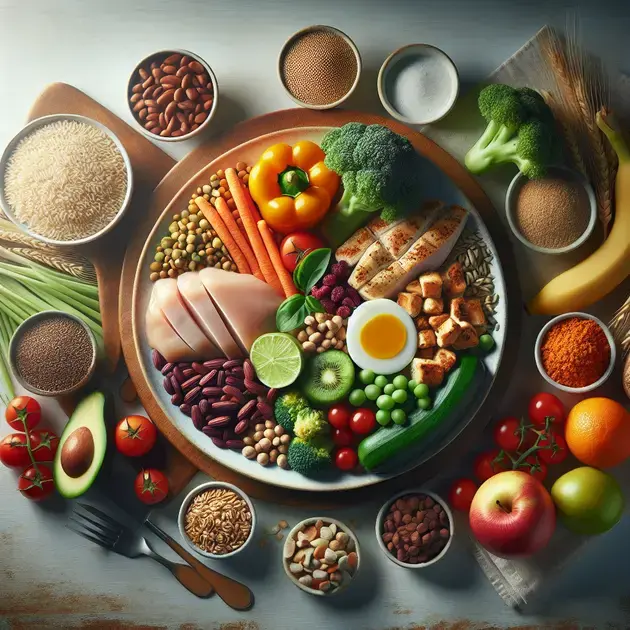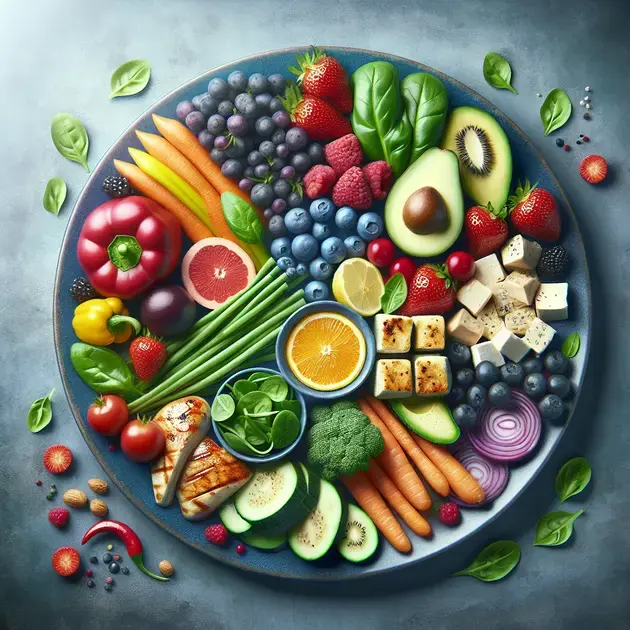Are you looking to shed some extra pounds naturally and effectively? Look no further! In today’s fast-paced world, maintaining a healthy weight can be a challenge, but incorporating the right foods into your diet can make all the difference. In this article, we’ll explore the top 10 foods that have been scientifically proven to help you lose weight naturally.
With obesity rates on the rise globally, it’s more important than ever to focus on our health and well-being. By choosing nutrient-dense and metabolism-boosting foods, you can not only reach your weight loss goals but also improve your overall health. Let’s dive into the world of nutrition and discover the power of these top 10 foods that can support your weight loss journey.
Fiber-rich Foods for Satiety and Digestive Health
Fiber-rich foods play a crucial role in promoting satiety and maintaining digestive health. By incorporating a variety of fiber sources into your diet, you can support healthy digestion and regulate your appetite. Here’s a step-by-step guide to identifying and including fiber-rich foods in your daily meals:
Step 1: Understand Different Types of Fiber
There are two main types of fiber: soluble and insoluble. Soluble fiber, found in foods like oats, nuts, and beans, dissolves in water to form a gel-like consistency that helps slow down digestion. Insoluble fiber, found in whole grains and vegetables, adds bulk to your stool and supports regular bowel movements.
Step 2: Identify High-Fiber Foods
Start by identifying high-fiber foods such as fruits (apples, berries), vegetables (broccoli, carrots), whole grains (quinoa, brown rice), legumes (lentils, chickpeas), and seeds (flaxseeds, chia seeds).
Step 3: Plan Fiber-Rich Meals
Create balanced meals that include fiber-rich foods from each category. For example, a breakfast bowl with oats, berries, and flaxseeds, a quinoa salad for lunch, and a lentil soup for dinner can help you meet your fiber needs.
Step 4: Consider Fiber Supplements
If you struggle to consume enough fiber through whole foods, consider incorporating fiber supplements into your daily routine. Psyllium husk and acacia fiber are popular options that can easily be added to smoothies or water.
Step 5: Stay Hydrated
Remember to drink plenty of water when increasing your fiber intake to help prevent constipation and aid in the digestion process.
Protein-packed Options to Boost Metabolism
Protein is essential for boosting metabolism and supporting muscle growth and repair. Including protein-rich foods in your diet can help you feel full, burn more calories, and maintain a healthy weight. Here’s a guide on how to choose protein-packed options:
Step 1: Opt for Lean Protein Sources
Choose lean protein sources such as skinless poultry, fish, tofu, tempeh, legumes, and low-fat dairy products. These options are lower in saturated fat and calories, making them ideal for boosting metabolism.
Step 2: Incorporate Protein into Every Meal
Make sure to include a source of protein in every meal and snack to help regulate blood sugar levels and curb cravings. Examples include Greek yogurt for breakfast, grilled chicken in salads, and nuts as a snack.
Step 3: Try Plant-based Protein Alternatives
If you follow a plant-based diet, explore protein alternatives such as quinoa, lentils, chickpeas, edamame, and plant-based protein powders. These options can provide all the essential amino acids needed for optimal metabolism.
Step 4: Prepare Protein-rich Recipes
Experiment with protein-rich recipes like lentil stews, chickpea curries, tofu stir-fries, and protein-packed smoothies to diversify your protein intake and keep your meals interesting.
Step 5: Be Mindful of Portion Sizes
While protein is beneficial for metabolism, consuming excessive amounts can lead to weight gain. Be mindful of portion sizes and aim to include a balanced mix of protein, carbohydrates, and fats in each meal.
Healthy Fats for Energy and Hormone Balancing
Healthy fats are essential for providing energy, supporting hormone production, and maintaining overall health. By choosing the right sources of healthy fats, you can enhance your energy levels and promote hormone balance. Here’s a breakdown on incorporating healthy fats into your diet:
Step 1: Include Omega-3-rich Foods
Omega-3 fatty acids are key for brain health and reducing inflammation. Include sources such as fatty fish (salmon, mackerel), chia seeds, walnuts, and flaxseeds in your diet to support energy levels and cognitive function.
Step 2: Opt for Monounsaturated Fats
Monounsaturated fats, found in olive oil, avocados, and nuts, can help lower bad cholesterol levels and improve heart health. Use olive oil for cooking, add avocado to salads, and snack on a handful of almonds for a boost of healthy fats.
Step 3: Choose Natural Nut Butters
Nut butters made from almonds, peanuts, or cashews are excellent sources of healthy fats and protein. Spread nut butter on whole grain toast, mix it into oatmeal, or blend it into smoothies for a delicious and nutritious addition to your diet.
Step 4: Cook with Coconut Oil
Coconut oil is a versatile cooking oil that contains medium-chain triglycerides (MCTs), known for their quick energy release and metabolism-boosting properties. Use coconut oil for sautéing, baking, or adding to smoothies for a tropical flavor.
Step 5: Balance Fat Intake
While healthy fats are beneficial, it’s important to consume them in moderation and balance them with other macronutrients. Be mindful of portion sizes and opt for whole food sources of fats to support energy production and hormone balancing.
**Fruits and Vegetables for Essential Nutrients**
Fruits for Essential Nutrients
Fruits are not only delicious, but they are also packed with essential nutrients that are crucial for our overall health. From vitamin C in oranges to potassium in bananas, fruits offer a wide range of vitamins and minerals that our bodies need to function properly. By incorporating a variety of fruits into our diet, we can ensure that we are getting all the essential nutrients we need to stay healthy.
Step-by-step guide:
1. Incorporate a mix of fruits into your daily meals, such as berries, citrus fruits, and tropical fruits.
2. Snack on fruits like apples, grapes, or pears for a healthy and satisfying treat.
3. Add fruits to your salads, smoothies, or oatmeal for a delicious and nutritious boost.
4. Experiment with different fruits to discover new flavors and textures that you enjoy.
5. Aim to include at least 5 servings of fruits in your daily diet to ensure you are getting a variety of essential nutrients.
Vegetables for Essential Nutrients
Vegetables are another important source of essential nutrients that are vital for our overall well-being. From leafy greens like spinach and kale to colorful veggies like bell peppers and carrots, there is a wide range of vegetables that offer a plethora of vitamins and minerals. By including a diverse selection of vegetables in our meals, we can ensure that we are getting all the essential nutrients our bodies need to thrive.
Step-by-step guide:
1. Incorporate a variety of vegetables into your meals, such as broccoli, cauliflower, and Brussels sprouts.
2. Roast, steam, or stir-fry vegetables to retain their nutrients and flavors.
3. Try new vegetables regularly to keep your meals exciting and diversified.
4. Include vegetables in your soups, stews, and pasta dishes for added nutrition.
5. Aim to fill half your plate with vegetables at each meal to ensure you are getting a good balance of essential nutrients.
**
Conclusion
**
Incorporating a colorful array of fruits and vegetables into our daily diet is paramount for maintaining optimal health and well-being. Fruits, rich in essential nutrients like vitamin C and potassium, play a crucial role in supporting our bodily functions and immune system. By diversifying our fruit intake with berries, citrus fruits, and tropical varieties, we can ensure we obtain a wide spectrum of vitamins and minerals necessary for a robust lifestyle.
On the other hand, vegetables offer another essential source of nutrients, from leafy greens to vibrant veggies, each providing a unique blend of vitamins and minerals crucial for our overall health. Including a variety of vegetables like broccoli, cauliflower, and Brussels sprouts in our meals not only adds flavor and texture but also ensures we receive the essential nutrients vital for our body to thrive.
By following a step-by-step guide that encourages us to explore new flavors, experiment with different produce, and aim for a balanced plate, we can cultivate a diet that is not only nutritious but also exciting and satisfying. Remember, the key to harnessing the benefits of fruits and vegetables lies in their diversity and incorporation into our daily meals, paving the way for a healthier and happier life.

